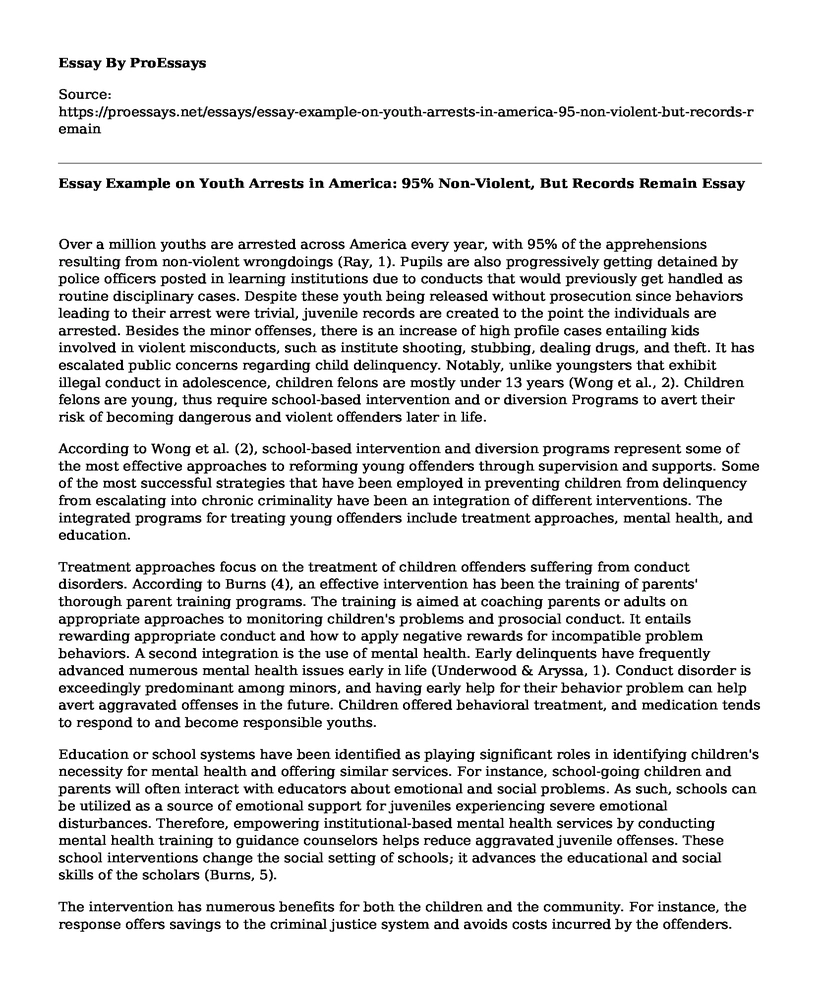Over a million youths are arrested across America every year, with 95% of the apprehensions resulting from non-violent wrongdoings (Ray, 1). Pupils are also progressively getting detained by police officers posted in learning institutions due to conducts that would previously get handled as routine disciplinary cases. Despite these youth being released without prosecution since behaviors leading to their arrest were trivial, juvenile records are created to the point the individuals are arrested. Besides the minor offenses, there is an increase of high profile cases entailing kids involved in violent misconducts, such as institute shooting, stubbing, dealing drugs, and theft. It has escalated public concerns regarding child delinquency. Notably, unlike youngsters that exhibit illegal conduct in adolescence, children felons are mostly under 13 years (Wong et al., 2). Children felons are young, thus require school-based intervention and or diversion Programs to avert their risk of becoming dangerous and violent offenders later in life.
According to Wong et al. (2), school-based intervention and diversion programs represent some of the most effective approaches to reforming young offenders through supervision and supports. Some of the most successful strategies that have been employed in preventing children from delinquency from escalating into chronic criminality have been an integration of different interventions. The integrated programs for treating young offenders include treatment approaches, mental health, and education.
Treatment approaches focus on the treatment of children offenders suffering from conduct disorders. According to Burns (4), an effective intervention has been the training of parents' thorough parent training programs. The training is aimed at coaching parents or adults on appropriate approaches to monitoring children's problems and prosocial conduct. It entails rewarding appropriate conduct and how to apply negative rewards for incompatible problem behaviors. A second integration is the use of mental health. Early delinquents have frequently advanced numerous mental health issues early in life (Underwood & Aryssa, 1). Conduct disorder is exceedingly predominant among minors, and having early help for their behavior problem can help avert aggravated offenses in the future. Children offered behavioral treatment, and medication tends to respond to and become responsible youths.
Education or school systems have been identified as playing significant roles in identifying children's necessity for mental health and offering similar services. For instance, school-going children and parents will often interact with educators about emotional and social problems. As such, schools can be utilized as a source of emotional support for juveniles experiencing severe emotional disturbances. Therefore, empowering institutional-based mental health services by conducting mental health training to guidance counselors helps reduce aggravated juvenile offenses. These school interventions change the social setting of schools; it advances the educational and social skills of the scholars (Burns, 5).
The intervention has numerous benefits for both the children and the community. For instance, the response offers savings to the criminal justice system and avoids costs incurred by the offenders. The intervention improves the health of the young individual by averting substance abuse. The educational approach is essential for enhancing scholarly output inform of increased high school completion and increased enrollments to higher education. To the parent, the method offers more time for them to spend with their children. Therefore, the diversion programs will help a reduction of early involvement in the juvenile delinquency system and reduce out-of-home placements for young children. Thus, diversion programs offer a second chance to children by helping them avert formal juvenile justice and even avert potential arrests, and thus cutting the flow of school to prison pipeline.
Conclusion
In conclusion, Children felons are young and require guidance such as school-based intervention and or diversion Programs to avert their risk of becoming dangerous and violent offenders later in life. It may involve school-based systems that play significant roles in identifying children's necessity for mental health. It may also include offering treatment approaches that focus on treating children offenders suffering from conduct disorders.
Works Cited
Burns, Barbara J. Treatment, services, and intervention programs for child delinquents. US Department of Justice, Office of Justice Programs, Office of Juvenile Justice and Delinquency Prevention, (2003). https://www.ncjrs.gov/pdffiles1/ojjdp/193410.pdf
Ray, James V. "Juvenile diversion." The Encyclopedia of Corrections (2017): 1-4.: https://onlinelibrary.wiley.com/doi/abs/10.1002/9781118845387.wbeoc026
Underwood, Lee A., and Aryssa, Washington. "Mental illness and juvenile offenders." International journal of environmental research and public health 13.2 (2016): 228. https://www.mdpi.com/1660-4601/13/2/228
Wong, Jennifer S., et al. "Can at-risk youth be diverted from crime? A meta-analysis of restorative diversion programs." Criminal Justice and Behavior 43.10 (2016): 1310-1329. Retrieved from: https://journals.sagepub.com/doi/abs/10.1177/0093854816640835
Cite this page
Essay Example on Youth Arrests in America: 95% Non-Violent, But Records Remain. (2023, May 08). Retrieved from https://proessays.net/essays/essay-example-on-youth-arrests-in-america-95-non-violent-but-records-remain
If you are the original author of this essay and no longer wish to have it published on the ProEssays website, please click below to request its removal:
- Harbet Packer and His Two Models of the Criminal Justice System
- Research Paper on Counterterrorism and Organized Crime Operations
- Essay Sample on War Measures Act
- Research Paper on Drug Epidemic in the United States
- Personal Liberty Violations Essay Example
- Research Paper on People Migrating From Villages to Towns During the Renaissance
- Paper Example on Chained & Mumbling: Mental Illness in West Africa







